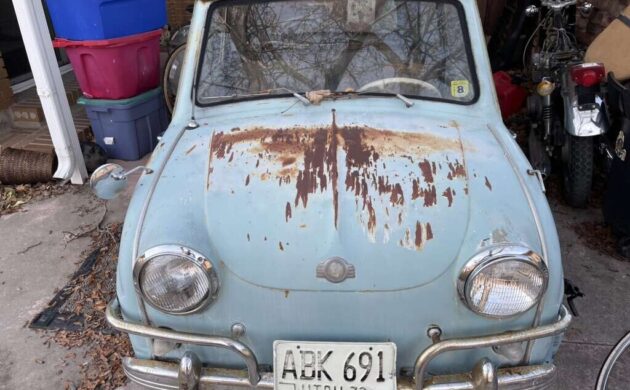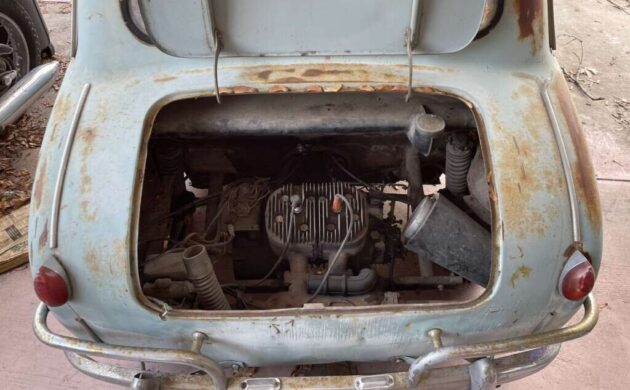Post-war Europe was a pretty miserable place as various countries struggled to rebuild their economies and destroyed infrastructure. Governments recognized the limitations and believed one strategy to accelerate the recovery was to get the population mobile. With materials in short supply, microcars became the order of the day. The Goggomobil T 250 was one such car, although they are rarely seen in North America. This one requires restoration but could be ideal for an enthusiast with limited workshop space. It is listed for sale here on KSL.Com in Orem, Utah. The seller set their price at $5,900, and I must say a big thank you to Barn Finder Bogie for spotting this diamond in the rough.
The Goggomobil was the product of Hans Glas GmbH, located in Dingolfing, Germany. The company produced several variants, including a two-door sedan and a coupe. The sedan was designed to carry four people, although, with limited back seat space, it was definitely a “two-adults and two-children” proposition. Our feature car is the entry-level T 250 model, and although it needs work, it appears complete. The pale blue paint has seen better days, with surface corrosion peeking through. The seller indicates there is little penetrating rust, although, in a car of these dimensions, there isn’t scope for a lot. The glass is in good order, and the trim looks restorable. These are easy to dismantle, making this Goggomobil the ideal candidate for restoration in a small home workshop.
One consistent characteristic of microcars is that they don’t offer outstanding performance. The Goggomobil T 250 is no exception. It features a rear-mounted 247cc two-cylinder air-cooled engine that churned out 13hp in its prime. The power fed to the road via a four-speed manual transaxle, and while the car weighed a mere 1,014 lbs, it would hardly set the world alight. The journey down the ¼-mile would take 28 seconds, with the engine running out of puff at 52mph. You were unlikely to be booked for speeding in a T 250, but receiving a ticket for obstructing traffic was a possibility! The engine is missing its air cleaner assembly, although I wouldn’t rule out finding it elsewhere in the car. Otherwise, it does appear complete. It doesn’t currently run, but with parts readily available and the simple nature of the drivetrain, returning it to active service should be possible without spending a fortune.
The Goggomobil’s interior has seen better days, and a retrim is on the cards. Locating the correct upholstery could prove challenging, meaning the new owner might need to find someone handy with a sewing machine to create replacement pieces. However, the existing components could serve as templates for an interior that appears complete. It may represent motoring at its most basic, but this T 250 features the optional factory radio.
The Goggomobil is a cool little classic that will appeal to enthusiasts passionate about microcars. Our Australian readers will probably recognize it from a television advertising campaign in the 1990s. The part of the ad where the owner spells the car’s name has become an integral part of the Australian dialect for an entire generation. Returning this gem to its former glory would be rewarding, and it would undoubtedly draw a crowd at a Cars & Coffee when the work is complete. Considering its overall simplicity, is it a project you might consider pursuing further?







250cc meant that in Germany it could be driven on a motorcycle license issued before c.1950.
That and an overall appearance that was more “very small real car” than “bubblecar” meant it outlasted its’ Isetta and Messerschmitt 250cc counterparts and was built into the late ’60s. Even then, demand may not have subsided entirely but the end came when BMW bought out Glas for its’ production capacity, not its’ nameplate or product line.
By the time BMW bought Glas, they were producing mid range sedans, coupes, and a Frua designed sports coupe. For a year or two after the purchase BMW made these cars with their own engines and drivetrain. The Frua coupe was nicknamed “Glaserati” and considered a hot car for its day.
You would be popular at your local cars and coffee events. Personally I don’t think I could resist installing a snow mobile engine to make it a real GoGomobile.
One of the great ad lines in AutoWeek was for a Gogomobile…”it’ll blow the door off an Isetta”….lol
Weber Co from Germany makes a 80 hp water cooled twin that would slip right in there. They were used by Redline on the Revolt ATV and also had a turbo version that puts out 125hp. Those would make the old girl a pretty cool sleeper.
Or as a commentator said of the early Mercedes diesels, “This isn’t life in the slow lane- it’s more like life in the bike path.”
Saw LOTS of these in Germany, while I was stationed there 1969-72.
My grandfather had one but it only had a drivers door. On the passenger side the “door” was imprinted in the sheet metal to look like it was a door. I’m not sure what model it was but it way enjoyed (not running) by us before we were old enough to drive.
So a Busa swap would elevate this car to dangerous levels, but it sure would be a sleeper.
Ha ha. The GoGo by Googlmobil
Buy it now put a geo metro drive train in it and this summer when gas hits $7.00 a gallon you can sell it for $10-$15k because people can’t do math
I’ll stick with my 96 Honda Hatchback… it is much cleaner, and I know it can get around the Village, and at 40 mpg, that will suffice. I doubt this thing could make some of our “hills” around here.
Any of these (all models) were just great.
I guess the Versa, Fit’n others are the modern version.
Hope such come out as EVs (below 30K$), verts, wagons, but
alas no money to B made by manufacturers on econo boxes = lill production
Keep your eye on “Aptera”. If it makes it to market this year, similar offerings are bound to follow.
Is the engine a 2-stroke?
I was walking along a deserted road near Trier Germany, in the dark of the night, listening to boars snuffling in the woods very close to me. Along came an old man in a Gogomobile who stopped to give me a ride. I can tell you that that was absolutely the most beautiful, comfortable automobile I had ever seen. The hum of the 2-cylinder, 2-stroke engine was music to my ears.
That was nearly 60 years ago and I remember it as if it were yesterday.
Hmm I have a Honda be 1100 cc water cooled with shaft drive I bet I could shoe horn in and make it a GoGo rocket LOL not a chance the wife would let me until all my other stuff is done but would be cool
Clearly a T400, as the 400 was the only engine used in US cars. US cars are easily identifiable by their very oversized headlights, unattractive extra tubing on the bumpers, and clear front indicator lenses. Nearly all US cars were fitted with the preselect transmission, as seen on this car. The (400 specific) air filter housing is also clearly visible in the engine compartment, so definitely not missing. Every piece of tinware and sealing rubber is missing from the engine compartment, however.
John,
I agree, it’s a T400 motor, from what I see [too dark to tell] is the carb missing?
As I’ve often said, the USA version of these cars makes sealed beam headlights look so big! I’ve worked on both the US and Euro spec Gogo cars.
In 1993 I was the US rep for a large worldwide car club {CAAR of France] that held a rallye every other year. In 1993 I invited club members to come visit the US, and about 150 vehicles and 400+ people from 18 countries drove their cars from the Baltimore/DC area to Chicago, where they picked up Rt 66 and drove all the way to Santa Monica, CA.
One of the entrants was a young couple and their Gogomobile TS Coupe, and each morning before sunup, they would rise, pack up their tent, and head out before anyone else. The Gogomobile was usually the last vehicle to show up at the evening campgrounds, as it was sooooo slow. But in that 3,800 mile trip across America, the little Gogo never broke down.